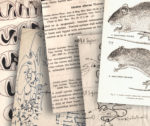A new species of spiny mouse, genus Neacomys (Cricetidae: Sigmodontinae) from Cordillera del Cóndor, Ecuador
Jorge Brito, Nicolás Tinoco, Santiago Burneo, Claudia Koch, Alfonso Arguero, Rocío Vargas, C. Miguel PintoWe describe a new species within the sigmodontine rodent genus Neacomys that inhabits the Cordillera del Cóndor, southeastern Ecuador. The new Neacomys is easily distinguished from other species in the genus by the combination of the following characters: small size (~69 mm of head-body length), moderately long tail (~55.5% longer than head-body length), venter fur with golden color, very large postglenoid foramen, anterocone of upper first molar undivided, presence of paralophule and spur of enamel on the upper first molar, upper molars with small labial cusps, and lower molars with small lingual cusps. Phylogenetic analyses based on cytochrome b gene (Cyt b) sequences indicate that the new species is sister to the “tenuipes” and “dubosti” groups. Given distinctive morphological characters we propose the recognition of a new species group for this new species. This new Neacomys, endemic to the Cordillera del Cóndor, presents a genetic distance between 12% and 15% to other species. Finally, we consider that N. amoenus carceleni exhibits sufficient distinctive genetic and morphological characteristics to be considered as a species. With the new entity described here and the change of status of N. carceleni, the diversity of the genus rises to 17 species. In this context, this small terrestrial oryzomyine appears an ideal candidate to contribute relevant information to the complex puzzle of Amazonian landscape evolution.
Una nueva especie de ratón espinoso del género Neacomys (Cricetidae: Sigmodontinae) de Cordillera del Cóndor, Ecuador. Describimos una nueva especie de roedor sigmodontino del género Neacomys que habita en la cordillera del Cóndor, sureste de Ecuador. La nueva entidad se distingue fácilmente de sus congéneres por la combinación de los siguientes caracteres: tamaño pequeño (longitud cabeza-cuerpo ~69 mm), cola larga (~55.5% más que la longitud cabeza-cuerpo), vientre con pelaje dorado; foramen postglenoideo muy grande, anterocono del primer molar superior no dividido, presencia de paralófulo y una proyección de esmalte en el primer molar superior; molares superiores con cúspides labiales reducidas y molares inferiores con cúspides linguales reducidas. Los análisis filogenéticos usando el gen mitocondrial citocromo b (Cyt b) indican que la especie nueva es hermana a los grupos «tenuipes» y «dubosti». Al presentar caracteres morfológicos distintivos, proponemos el reconocimiento de un nuevo grupo para contenerla. Esta nueva especie, endémica de la Cordillera del Cóndor, presenta una distancia genética entre 12% y 15% con los grupos ya conocidos. Finalmente, consideramos que N. amoenus carceleni presenta características morfológicas y genéticas suficientemente diferentes para ser tratada como especie válida. Con la nueva entidad aquí descrita y el cambio de categoría de N. carceleni, la diversidad del género Neacomys asciende a 17 especies. En este contexto, este pequeño orizomino terrestre parece ser un candidato ideal para contribuir información relevante al complejo rompecabezas del panorama evolutivo amazónico.
